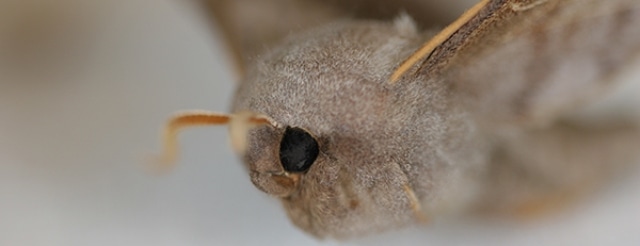May 4 2016
There is a clear difference between a snake's skin and moth's eyes. Scientists at Kiel University have developed a new technique that brings this so-called 'apples and oranges' to a common level. This unique approach has given way to an entirely new and comparative outlook on biological surfaces, and provides a better understanding of how these surfaces actually work.
 Looking straight in the eye. Kiel’s scientists explore the nanostructure of animal cells. Photo, Copyright: Eulitz/Gorb
Looking straight in the eye. Kiel’s scientists explore the nanostructure of animal cells. Photo, Copyright: Eulitz/Gorb
The researchers, Dr. Alexander Kovalev, Professor Stanislav Gorb, and Dr. Alexander Filippov from the Zoological Institute at Kiel University, have reported the results of the study in the recent edition of the scientific journal, Applied Physics A.
One surface is resistant to water and abrasion, while the other shows reduced light reflection. In the animal world, surfaces adapt to their environments over time and provide the greatest evolutionary benefit to animals. However, researchers are still confused as to why and how these different types of structures develop in a detailed and organized way. Using new research techniques, a present study directly looks into the surface nano-structures.
Humans would generally make comparisons within closely associated species and would simply look at the surface’ tiny areas, says Gorb:
That is why we asked ourselves which structural differences can be found between completely different species. To do so, we changed biology's typical perspective and addressed larger surface areas from various species.
Professor Stanislay Gorb, Zoological Institute, Kiel University
In other inorganic or technical fields, these kinds of cross-material studies or cross-species of nanostructures are very common. However, when it comes to biology, this technique is entirely different, Gorb continues.
The concept initially evolved from the decorations made in the hallway of Kiel University, which displays scanning electron microscope images of snake's skin and moth's eyes. At one stage of time, Filippov, a theoretical physicist, observed similarities between these images that revealed the surfaces at a resolution of several millionths of a millimeter. Dimples and nipples were seen that appeared to follow a specific pattern.
The researchers used methods that are generally applied in crystallography and eventually detected the specific patterns, which clearly differentiate the two species.
The structure of moth's eyes is perfectly organized. Nipples are highly ordered, and preferred directions are exhibited in the structural organization.
Dr. Alexander Kovalev, Zoological Institute, Kiel University
Although the team was aware of the strict symmetry of the eye structure, the fact that this symmetry goes right through the surface nano-structures and is repeated over the whole surface in so-called domains is indeed a major breakthrough. Initially, the symmetry of the snake's skin seems to be similar and may appear to be better organized, but this is not so.
Compared to the structure of the moth's eye, the structure of the snake's skin is unorganized. f we concentrate on one dimple in the skin, like one nipple in the eye, we only see a diffuse cloud of further dimples in the close surroundings. Neither particular directions nor the regular arrangement can be defined. This unorganized structure continues across the entire surface.
Dr. Alexander Kovalev, Zoological Institute, Kiel University
If viewed separately, these latest findings regarding the organized eye structure and the unorganized skin structure are not particularly important. However, by considering the common denominator, that is examining both sets of structures with the same level of resolution, it would be possible to compare the inherently varied structures.
However, the ‘coincidental’ degree of organization is not coincidental, but a result of evolution. That would mean that the perfect organization gives the moth its incredible night vision, while the imperfect organization in snake's skin ensures the best friction properties.
Professor Stanislay Gorb, Zoological Institute, Kiel University
This appears to be reasonable, if we go by the laws of physics that a symmetrical structure is required for superior vision and that the surface ordering in contact with the ground must remain as low as possible to provide good friction properties.
If the Kiel University team had followed the traditional methods and compared moths to moths and snakes to snakes, then the elemental organization at nano-level would not have been considered important.
By comparing evolutionary distant species, we now see that the key to understanding surface functions must be right at the smallest level. Every biological surface is adapted to its environment, and these adaptations are reflected in the organization of their smallest elements in a certain perfect or imperfect degree.
Professor Stanislay Gorb, Zoological Institute, Kiel University